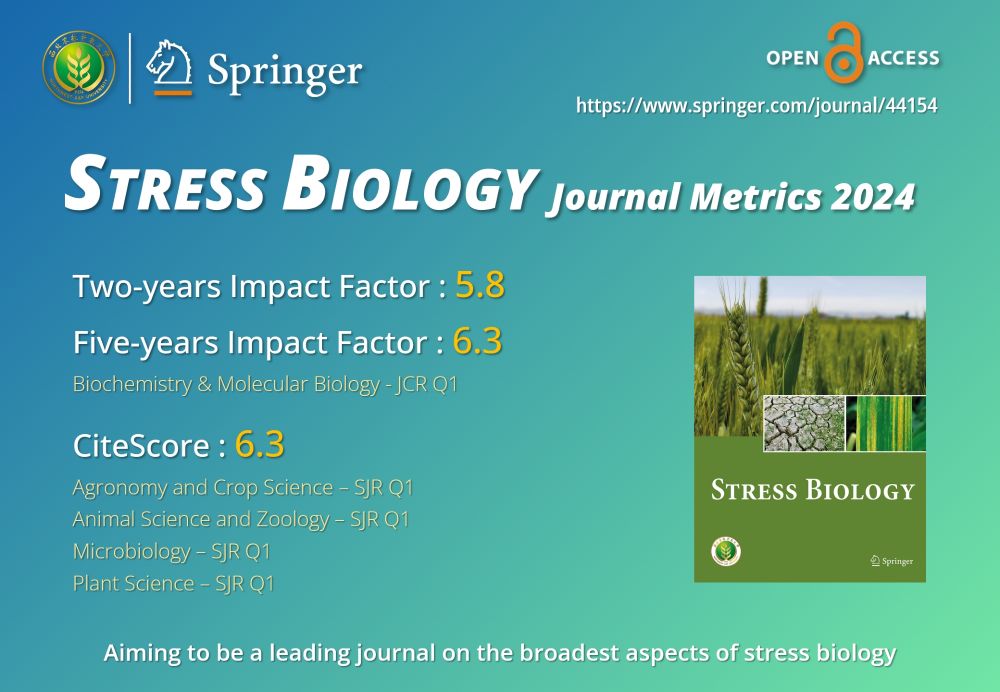
https://www.springer.com/journal/44154

Qingqing Hou & Xuewei Chen
link.springer.com/article/10.1...
#SBRR1 #RhizoctoniaSolani #PlantImmunity @natgenet.nature.com

Qingqing Hou & Xuewei Chen
link.springer.com/article/10.1...
#SBRR1 #RhizoctoniaSolani #PlantImmunity @natgenet.nature.com
Tamana Khan, Labiba Shah ... Faheem Shahzad Baloch, Sheikh Mansoor
link.springer.com/article/10.1...
#MAPK #multiomics #hormone

Tamana Khan, Labiba Shah ... Faheem Shahzad Baloch, Sheikh Mansoor
link.springer.com/article/10.1...
#MAPK #multiomics #hormone
Zhixin Liu, Yixin Zhang ... Guoyong An, Xuwu Sun
link.springer.com/article/10.1...
#ScRNAseq #regeneration #dedifferentiation

Zhixin Liu, Yixin Zhang ... Guoyong An, Xuwu Sun
link.springer.com/article/10.1...
#ScRNAseq #regeneration #dedifferentiation
Jianqing Zhao, Weiwei Yao ... Hengbo Shi, Jun Luo
link.springer.com/article/10.1...
#GWAS #adaptation #goatBreeding

Jianqing Zhao, Weiwei Yao ... Hengbo Shi, Jun Luo
link.springer.com/article/10.1...
#GWAS #adaptation #goatBreeding
Xiaohua Dong, Xiaoyan Zhang ... Gan Ai, Daolong Dou
link.springer.com/article/10.1...
#NLR #plantimmunity #tradeoff #plantgrowth

Xiaohua Dong, Xiaoyan Zhang ... Gan Ai, Daolong Dou
link.springer.com/article/10.1...
#NLR #plantimmunity #tradeoff #plantgrowth
Daiyuan Sun, Chengliang Li ... Chenfang Wang, Guanghui Wang
link.springer.com/article/10.1...
#wheat #DON #plantimmunity

Daiyuan Sun, Chengliang Li ... Chenfang Wang, Guanghui Wang
link.springer.com/article/10.1...
#wheat #DON #plantimmunity
Xinchang Hao, Yiwen Li ... Qin Peng, Xili Liu
link.springer.com/article/10.1...
#succinatedehydrogenaseinhibitor #Sdh #drugresistance
Xinchang Hao, Yiwen Li ... Qin Peng, Xili Liu
link.springer.com/article/10.1...
#succinatedehydrogenaseinhibitor #Sdh #drugresistance
Lefan Pu, Qiaojun Jin ... Zhensheng Kang, Jun Guo
link.springer.com/article/10.1...
#wheat #bioticstress #PlantMicrobeInteraction

Lefan Pu, Qiaojun Jin ... Zhensheng Kang, Jun Guo
link.springer.com/article/10.1...
#wheat #bioticstress #PlantMicrobeInteraction
Yanan Duan, Ziqing Ma ... Chao Li, Fengwang Ma
link.springer.com/article/10.1...
#apple #bioticstress #microbiomeEngineering

Yanan Duan, Ziqing Ma ... Chao Li, Fengwang Ma
link.springer.com/article/10.1...
#apple #bioticstress #microbiomeEngineering
Mengying He, Shan Zhang ... Ning Wang, Xiaojie Wang
link.springer.com/article/10.1...
#wheat #plantimmunity #cellwall

Mengying He, Shan Zhang ... Ning Wang, Xiaojie Wang
link.springer.com/article/10.1...
#wheat #plantimmunity #cellwall
Jiang Gao, Hongrui Ren ... Bin He, Wenqiang Ma
link.springer.com/article/10.1...
#Metabolomic #Transcriptomic #IntestinalBarrier

Jiang Gao, Hongrui Ren ... Bin He, Wenqiang Ma
link.springer.com/article/10.1...
#Metabolomic #Transcriptomic #IntestinalBarrier
Xiaoying Yang, Maoru Xu ... Chunhuan Chen, Wanquan Ji
link.springer.com/article/10.1...
#FHB #transcriptome #DiseaseResistance #PlantImmunity

Xiaoying Yang, Maoru Xu ... Chunhuan Chen, Wanquan Ji
link.springer.com/article/10.1...
#FHB #transcriptome #DiseaseResistance #PlantImmunity
Xudong Guo, Xiaoyue Yuan ... Dejun Ji, Yuting Guo
link.springer.com/article/10.1...
#Histonemodifications #ROS #DON

Xudong Guo, Xiaoyue Yuan ... Dejun Ji, Yuting Guo
link.springer.com/article/10.1...
#Histonemodifications #ROS #DON
Ting Li, Sujuan Xu, Yinyi Zhang, Liping Ding, Ze Wu, Nianjun Teng
link.springer.com/article/10.1...
#HSFB #HeatStress #AbioticStress

Ting Li, Sujuan Xu, Yinyi Zhang, Liping Ding, Ze Wu, Nianjun Teng
link.springer.com/article/10.1...
#HSFB #HeatStress #AbioticStress
Ting Li, Sujuan Xu, Yinyi Zhang, Liping Ding, Ze Wu & Nianjun Teng
link.springer.com/article/10.1...
#HSFs #HeatStress #AbioticStress

Ting Li, Sujuan Xu, Yinyi Zhang, Liping Ding, Ze Wu & Nianjun Teng
link.springer.com/article/10.1...
#HSFs #HeatStress #AbioticStress
Fang Zhi, Tianle Fan ... Fengwang Ma, Xuewei Li, Qingmei Guan
link.springer.com/article/10.1...
#Apple #AbioticStress #Breeding

Fang Zhi, Tianle Fan ... Fengwang Ma, Xuewei Li, Qingmei Guan
link.springer.com/article/10.1...
#Apple #AbioticStress #Breeding
Hu Su, Hu Jiang, Carly Anderson Stewart, Dina Clark, Sukuan Liu & Erin A. Manzitto-Tripp
link.springer.com/article/10.1...
#trailDevelopment #flavonoid #plantDiversity

Hu Su, Hu Jiang, Carly Anderson Stewart, Dina Clark, Sukuan Liu & Erin A. Manzitto-Tripp
link.springer.com/article/10.1...
#trailDevelopment #flavonoid #plantDiversity
Kifle Gebreegziabiher Gebretsadik, Zhixin Liu ... Lam-Son Phan Tran, Xuwu Sun
link.springer.com/article/10.1...
#PlantImmunity #PRR #BioticStress

Kifle Gebreegziabiher Gebretsadik, Zhixin Liu ... Lam-Son Phan Tran, Xuwu Sun
link.springer.com/article/10.1...
#PlantImmunity #PRR #BioticStress
Juan Wang, Lu Bai ... Shoucai Ma, Jiangbo Fan
link.springer.com/article/10.1...
#RLCK #PlantImmunity #BioticStress

Juan Wang, Lu Bai ... Shoucai Ma, Jiangbo Fan
link.springer.com/article/10.1...
#RLCK #PlantImmunity #BioticStress

Napassorn Thamkirati ... Suphattra Janthasri, Chatchawan Jantasuriyarat
link.springer.com/article/10.1...
#breeding #marker #bioticstress

Napassorn Thamkirati ... Suphattra Janthasri, Chatchawan Jantasuriyarat
link.springer.com/article/10.1...
#breeding #marker #bioticstress
Tan Dai, Jikun Yang, Shiping Hu, Chuang Zhao, Kang Yuan, Jianqiang Miao & Xili Liu
link.springer.com/article/10.1...
#Fluopicolide #Litchi #BioticStress

Tan Dai, Jikun Yang, Shiping Hu, Chuang Zhao, Kang Yuan, Jianqiang Miao & Xili Liu
link.springer.com/article/10.1...
#Fluopicolide #Litchi #BioticStress
Chuangfeng Liu, Yang Wang ... Yiji Xia, Liming Xiong
link.springer.com/article/10.1...
#RBP #Condensate #GABA #AbioticStress

Chuangfeng Liu, Yang Wang ... Yiji Xia, Liming Xiong
link.springer.com/article/10.1...
#RBP #Condensate #GABA #AbioticStress
Yangzhi Liu, Boqiang Li, Tong Chen, Shiping Tian & Zhanquan Zhang
link.springer.com/article/10.1...
#Trehalose6phosphate #Biosynthesis #metabolism

Yangzhi Liu, Boqiang Li, Tong Chen, Shiping Tian & Zhanquan Zhang
link.springer.com/article/10.1...
#Trehalose6phosphate #Biosynthesis #metabolism
Erbo Niu, Yibin Zhang ... Huixia Li, Jiahui Wang
link.springer.com/article/10.1...
#StripeRust #Wheat #BioticStress

Erbo Niu, Yibin Zhang ... Huixia Li, Jiahui Wang
link.springer.com/article/10.1...
#StripeRust #Wheat #BioticStress

